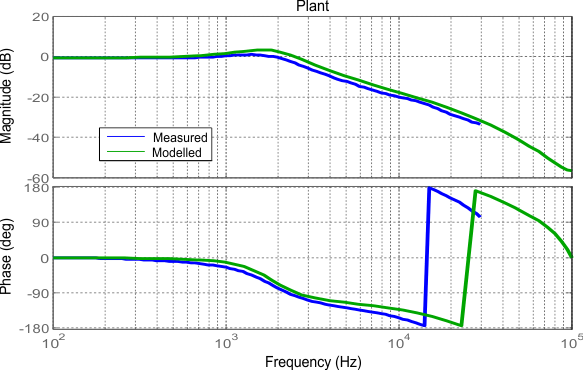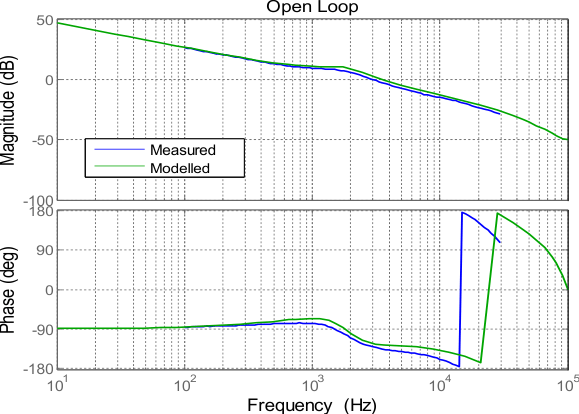SPRUIK4A September 2018 – June 2019 TMS320F280021 , TMS320F280021-Q1 , TMS320F280023 , TMS320F280023-Q1 , TMS320F280023C , TMS320F280025 , TMS320F280025-Q1 , TMS320F280025C , TMS320F280025C-Q1 , TMS320F280040-Q1 , TMS320F280040C-Q1 , TMS320F280041 , TMS320F280041-Q1 , TMS320F280041C , TMS320F280041C-Q1 , TMS320F280045 , TMS320F280048-Q1 , TMS320F280048C-Q1 , TMS320F280049 , TMS320F280049-Q1 , TMS320F280049C , TMS320F280049C-Q1 , TMS320F28075 , TMS320F28075-Q1 , TMS320F28076 , TMS320F28374D , TMS320F28374S , TMS320F28375D , TMS320F28375S , TMS320F28375S-Q1 , TMS320F28376D , TMS320F28376S , TMS320F28377D , TMS320F28377D-Q1 , TMS320F28377S , TMS320F28377S-Q1 , TMS320F28378D , TMS320F28378S , TMS320F28379D , TMS320F28379D-Q1 , TMS320F28379S
-
C2000 Software Frequency Response Analyzer (SFRA) Library and Compensation Designer in SDK Framework
- Trademarks
- 1 Introduction
- 2 Installing the SFRA Library
- 3 Module Summary
- 4 Compensation Designer
- 5 Case Study
- 6 Running Software Test Bench Example for SFRA
- 7 Using SFRA Without SFRA GUI Integration
- 8 FAQ
- Revision History
5.4 Comparing SFRA Measured Frequency Response Versus Modeled
The SFRA library has been run successfully on a number of power topologies. The following section shows the comparison between modeled and measured frequency responses on the DPSWorkshop board, which is a buck converter. This clearly shows that the modeling was close enough to what was measured and vice versa. Some margin of error is expected due to parameter estimation error and non ideality of the model.
 Figure 15. Plant Frequency Response Modeled vs Measured on DPSWrkShpKit
Figure 15. Plant Frequency Response Modeled vs Measured on DPSWrkShpKit  Figure 16. Open Loop Frequency Response Modeled vs Measured on DPSWrkShpKit
Figure 16. Open Loop Frequency Response Modeled vs Measured on DPSWrkShpKit The SFRA GUI has been validated in the following TI Designs for different topologies.
- Buck (BOOSTXL-BUCKCONV): SFRA verified with model for voltage loop operation.
- Single Phase Bridged Boost PFC (TMDSILPFCKIT): SFRA verified with model for current loop and voltage loop.
- Solar Micro Inverter Kit (TMDSSOLARUINVKIT) : Grid connected inverter current control loop verified with model and SFRA measurements. Flyback and the DC Bus regulation loop design based on SFRA plant measurement.
- LLC converter (TIDM-1001, TMDSHVRESLLCKIT): Voltage loop designed using SFRA for LLC converter.
- Totem Pole PFC (TIDM-1007, TIDA-01604): Voltage and current loop for PFC verified with SFRA and model comparison.
- Three Phase PFC using Vienna rectifier (TIDM-1000): Voltage loop and current loop verified from the model and compared with SFRA. DC Balance loop verified with SFRA measurement.
- Critical Mode PFC (TIDA-0961)
- Motor Control with FCL
- Votage source inverter (TIDM-HV-1PH-DCAC) Inner current loop and outer voltage loop with proportional resonant controllers verified with SFRA.
- Grid connected inverter (TIDM-HV-1PH-DCAC) Grid connected current loop verified with SFRA.
- In addition to the above, a software test bench is also provided as part of the SFRA package to self test the SFRA algroithm that is outlined in Section 6.